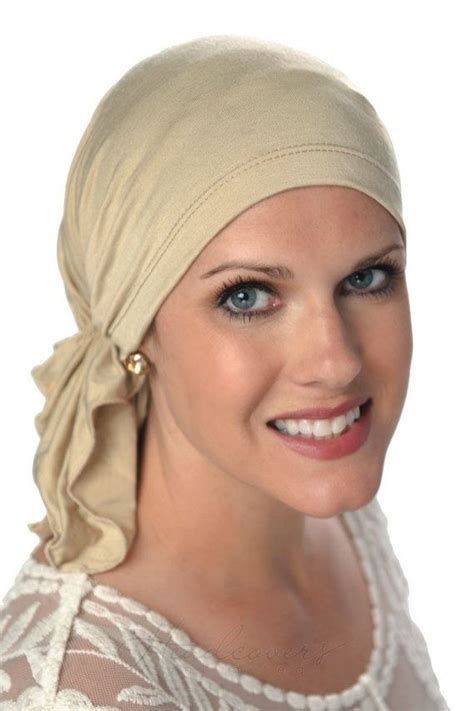A cancer diagnosis can bring about a multitude of physical and emotional changes, including hair loss. For many women, this can be a particularly distressing side effect. Head scarves offer a simple yet elegant way to cover hair loss and protect sensitive scalps while maintaining a sense of style.

The Benefits of Head Scarves
Head scarves provide numerous benefits for women with cancer, including:
- Concealing hair loss: Scarves effectively cover hair loss, providing a solution for women who prefer to maintain a more “normal” appearance.
- Protecting the scalp: Cancer treatments can make the scalp sensitive and vulnerable. Scarves shield the scalp from sun, wind, and cold, reducing irritation and discomfort.
- Emotional comfort: Scarves can provide a sense of security and comfort, helping women cope with the emotional challenges of cancer treatment.
- Stylish accessories: Scarves come in a wide range of colors, patterns, and fabrics, allowing women to express their personal style while covering their hair loss.
Choosing the Right Head Scarf
Selecting the right head scarf can enhance comfort and style. Here are some factors to consider:
Material: Choose breathable, soft fabrics like cotton, silk, or bamboo. These fabrics minimize scalp irritation and wick away moisture.
Size: Scarves should be large enough to cover the entire scalp and hairline comfortably without being too bulky or restrictive.
Shape: Different scarf shapes suit various face shapes. Experiment with square, triangle, or rectangular scarves to find what complements your features best.
Color and Pattern: Choose scarves that complement your skin tone and overall style. Consider both solid colors and patterned designs to create different looks.
Styling Head Scarves
There are countless ways to style head scarves. Here are a few popular methods to try:
- Turban: Fold a square scarf diagonally and place the center point on the top of your head. Bring the ends to the back and tie them together.
- Knot: Tie a scarf at the back of your head and then bring the ends to the front. Tie a second knot at the front for a secure fit.
- Beret: Drape a rectangular scarf over your head and secure it with a knot or headband. Pull the scarf down over your forehead to create a beret-like shape.
- Hatband: Use a narrow scarf to wrap around the brim of a hat, adding a touch of color and style.
Head Scarves for Special Occasions
Scarves can also elevate your look for special occasions. Consider these styling tips:
- Weddings: Pair a delicate lace or silk scarf with a formal dress for a sophisticated evening look.
- Job Interviews: Opt for a solid-colored scarf in a neutral hue to convey professionalism and confidence.
- Parties: Experiment with bold patterns and bright colors for a fun and festive touch to your ensemble.
Scarves as a Symbol of Strength
Head scarves have become more than just a practical accessory for women with cancer. They symbolize resilience, strength, and beauty. The following statistics highlight the prevalence of head scarf use among cancer patients:
- According to the American Cancer Society, approximately 70% of women undergoing chemotherapy experience hair loss.
- A study published in the Journal of Clinical Oncology found that 85% of women with cancer used head scarves to cover their hair loss.
- A survey by the National Cancer Institute reported that 90% of women with cancer felt more confident and comfortable with themselves when wearing a head scarf.
Headscarves: Beyond Cancer
The concept of headscarves as a means of covering the head for various reasons dates back centuries. Here are some creative ideas for new applications:
Religious head coverings: Head scarves can be adapted as a modest and stylish alternative to traditional religious head coverings like hijabs or yarmulkes.
Protective gear for outdoor activities: Scarves can protect the head and neck from the sun’s harmful UV rays, insects, or cold weather.
Workout headbands: A wide scarf can be tied around the head as a breathable and moisture-wicking headband during workouts.
Accessories and Care
Scarf jewelry: Add a touch of sparkle to your scarf with decorative pins, brooches, or hair combs.
Scarf clips: Secure scarves in place with discreet scarf clips that prevent slipping or tangling.
Care instructions: Hand wash or machine wash scarves on delicate settings using mild detergents. Avoid fabric softeners that may damage delicate fabrics.
Conclusion
Head scarves are an essential accessory for women with cancer, offering both practical and emotional benefits. From concealing hair loss to providing emotional comfort, scarves empower women to maintain their sense of style and confidence throughout their cancer journey. With a wide range of materials, sizes, shapes, and styles available, there is a scarf out there for every woman to feel beautiful and supported.
